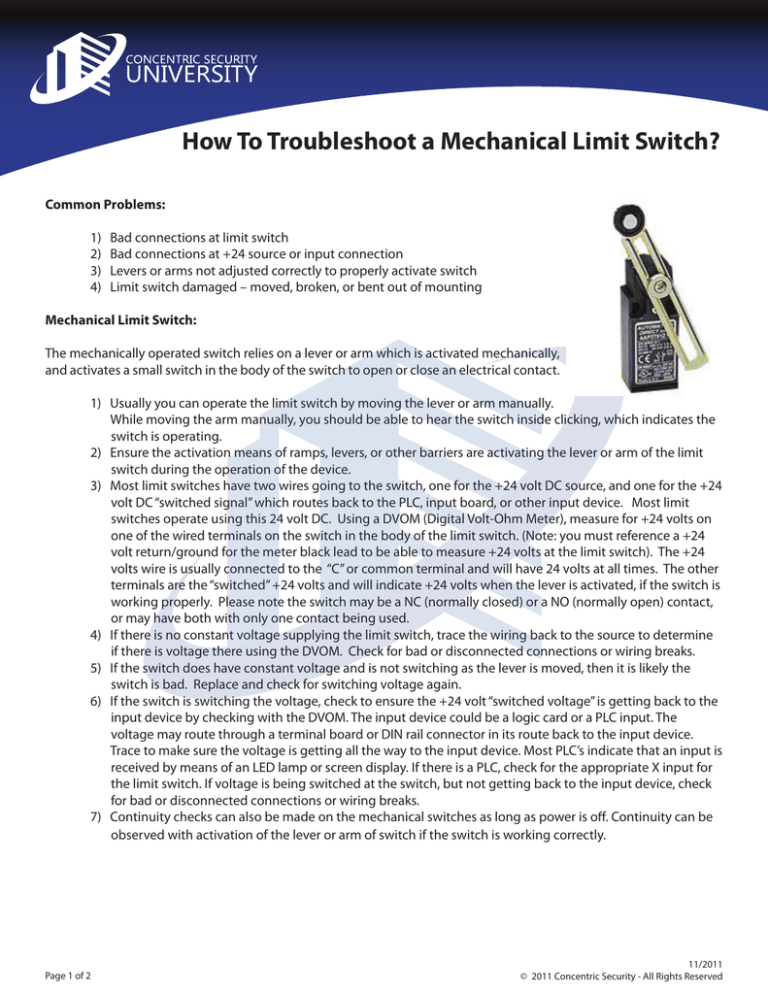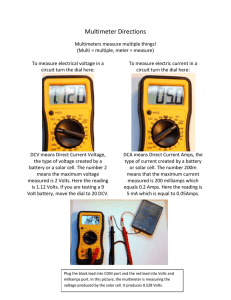
How To Troubleshoot a Mechanical Limit Switch?
Common Problems:
1)
2)
3)
4)
Bad connections at limit switch
Bad connections at +24 source or input connection
Levers or arms not adjusted correctly to properly activate switch
Limit switch damaged – moved, broken, or bent out of mounting
Mechanical Limit Switch:
The mechanically operated switch relies on a lever or arm which is activated mechanically,
and activates a small switch in the body of the switch to open or close an electrical contact.
1) Usually you can operate the limit switch by moving the lever or arm manually. While moving the arm manually, you should be able to hear the switch inside clicking, which indicates the
switch is operating.
2) Ensure the activation means of ramps, levers, or other barriers are activating the lever or arm of the limit
switch during the operation of the device.
3) Most limit switches have two wires going to the switch, one for the +24 volt DC source, and one for the +24
volt DC “switched signal” which routes back to the PLC, input board, or other input device. Most limit
switches operate using this 24 volt DC. Using a DVOM (Digital Volt-Ohm Meter), measure for +24 volts on
one of the wired terminals on the switch in the body of the limit switch. (Note: you must reference a +24
volt return/ground for the meter black lead to be able to measure +24 volts at the limit switch). The +24
volts wire is usually connected to the “C” or common terminal and will have 24 volts at all times. The other
terminals are the “switched” +24 volts and will indicate +24 volts when the lever is activated, if the switch is
working properly. Please note the switch may be a NC (normally closed) or a NO (normally open) contact,
or may have both with only one contact being used.
4) If there is no constant voltage supplying the limit switch, trace the wiring back to the source to determine
if there is voltage there using the DVOM. Check for bad or disconnected connections or wiring breaks.
5) If the switch does have constant voltage and is not switching as the lever is moved, then it is likely the switch is bad. Replace and check for switching voltage again.
6) If the switch is switching the voltage, check to ensure the +24 volt “switched voltage” is getting back to the
input device by checking with the DVOM. The input device could be a logic card or a PLC input. The
voltage may route through a terminal board or DIN rail connector in its route back to the input device. Trace to make sure the voltage is getting all the way to the input device. Most PLC’s indicate that an input is
received by means of an LED lamp or screen display. If there is a PLC, check for the appropriate X input for
the limit switch. If voltage is being switched at the switch, but not getting back to the input device, check
for bad or disconnected connections or wiring breaks.
7) Continuity checks can also be made on the mechanical switches as long as power is off. Continuity can be
observed with activation of the lever or arm of switch if the switch is working correctly.
Page 1 of 2
11/2011
© 2011 Concentric Security - All Rights Reserved
Other Considerations:
In some systems, the limit switches may be connected in series, especially bollards which work in unison. For example,
a set of 5 bollards may have all 5 up limit switches wired in series, or may have all 5 down limit switches wired in series.
In this case all 5 up (or down) limit switches must be activated to have the “switched” voltage back to the input device.
But, in this configuration the +24 volts which is “switched” is provided to the next switch and then to the next switch
and so on in series. In this case it will be more difficult to troubleshoot if there is a failed limit switch. If the switches
are purely mechanical, continuity checks can be made on each switch individually. Voltage checks can be made at
each to determine where the +24 volts is no longer present.
There are also some simple magnetic-type switches used in systems which work by a magnet being attracted to a
ferrous metal activation device. In this case, continuity checks can be made.
Concentric Security University
7560 Main Street, Sykesville, MD 21784
P 410.552.9950 F 410.552.9939
Website: www.ConcentricU.com
Email: info@ConcentricU.com
Page 2 of 2
11/2011
© 2011 Concentric Security - All Rights Reserved


